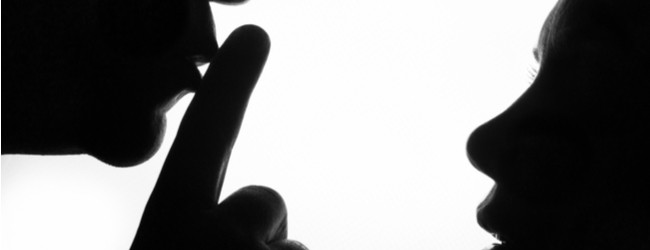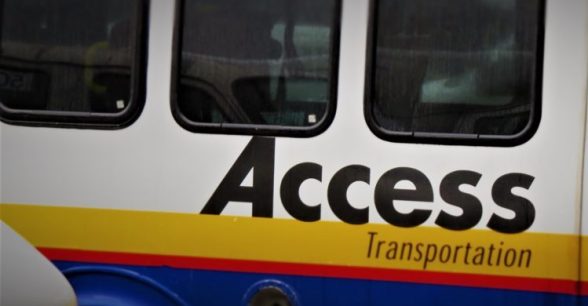We Cannot Ignore the Connection Between Disability and Intimate Partner Abuse
This blog post is part of a series in partnership with the Disability Visibility Project® to bring attention to the omission of disability from larger conversations taking place within the #MeToo Movement.
Trigger warning: this post discusses abuse, violence, and mental illness.
Disabled people are at a higher risk of violence than nondisabled people, and yet they’re often left out of conversations about the epidemic of intimate partner violence in the United States. The collective failure on the part of society, advocacy organizations, and law enforcement to recognize this issue — and the unique factors involved in abusive relationships for disabled people — makes it much more challenging to take action.
Disabled people in general are often left behind by activism and awareness campaigns, a reminder that some people view disability as something separate and isolated from society. Moreover, when conversations do include disability, they often involve nondisabled people speaking for the disability community. The assumption that disabled people don’t date, have relationships, or marry can play a minimizing role, as people assume intimate partner violence doesn’t affect the disability community — or that it only involves disabled women, and is only committed by men.
The silence on intimate partner violence and disability isn’t just a disservice to people experiencing or recovering from abusive relationships. It also makes disabled people an easy target, especially when they sit at the intersection of multiple identities. Robin Eames, an Australian disability activist and writer, is acutely aware of this. They experienced it firsthand with a former abusive partner: “He consistently targeted young autistic people who were either questioning their gender/sexuality or were in the early stages of transitioning.”
For disabled people, intimate partner violence doesn’t always take familiar forms
When people think about intimate partner violence, they may think in stereotypes: A screaming man, hitting, throwing things, threatening people. Men, of course, are not the only ones who are abusive, and violence can take place without a single blow, but relationships sitting outside the stereotypes often fly under the radar. For LGBQT disabled people, for example, attitudes about their gender and sexuality can further hinder access to justice. Abuse in the context of LGBQT relationships is often a taboo topic, and myths that abuse doesn’t happen in the context of LGBQT relationships are common. These myths also extend to abusers, with a cultural attitude that disabled people cannot themselves be abusive.
Physical and verbal violence can be present in relationships where disability is involved, but it also takes more nuanced, complicated forms that might not be immediately readable to outsiders in the relationship. In fact, sometimes abuse even appears to be caring, or the work of a dedicated, loving partner. And emotional abuse in disability contexts can look very different than it does in nondisabled relationships.
Eames and Karin Willison had partners who lived in their homes rent-free and took advantage of them, but still presented themselves as loving care providers. Abusers may make their targets feel like “burdens” while maintaining an outward appearance of being caring and loving; martyrs to their “needy and controlling” partners. That intersection of abuser and care provider can make a relationship difficult to escape, especially when it includes financial abuse like draining bank accounts and seizing benefits checks.
“The lack of freedom of movement was really stifling and it made it hard to have my own friends and my own life,” says Eames. That experience was echoed by Jack, who was trapped in their abusive partner’s apartment for hours or even days at a time because the building wasn’t wheelchair accessible. Trapping people at home, as Ivy Marks’ partner also did, limits their ability to socialize, interact with people, see healthy relationships, and ask for help.
And for disabled people who can’t work, their inability to work can become a point of abuse in relationships as well. Abusive partners characterize their targets as “lazy” or imply that they’re doing all the work, expressing resentment about doctor’s appointments and other needs. Cassandra J. Perry’s partner once accused her of “playing the disability card,” expressing irritation with her disability-related limitations.
There are other direct intersections with disability that can obscure abuse — some people, for example, are more prone to cuts, bruises, and joint dislocations. Partners who are aware of this may exploit it, as Eames’ partner and Marks’ both did. Health care providers who aren’t looking for abuse may accept something like “they fell down” as an excuse.
Perry also commented that her abuser took advantage of the fact that some of her medications altered her level of consciousness. She woke more than once to her partner “climbing on top of me” despite her cries to stop — and these incidents raise troubling questions about how many times she was raped in her sleep.
Abusers may also engage in tactics like moving, hiding, or discarding medications, mobility aids, and other needed disability supplies. Marks’ partner interfered with her medications as well, in addition to placing objects in her way and trapping her with boxes so she couldn’t leave rooms.
For mentally ill people, a history of mental and/or chronic illness can become a weapon. “He also used my depression and other mental health issues to help convince me I was worthless and everyone hated me, so I had to depend solely on him,” Rachel Tanner told Rooted in Rights. “One commonality in many invisible chronic illnesses is healthcare professionals (and the general public) making us feel like we’re not actually sick and we’re making up the whole thing. My ex capitalized on that and often told me I wasn’t actually sick.”
Agnieszka K.’s partner was also mentally ill, and he used this against her, attempting to blame their relationship problems on their mutual mental illnesses. When she finally filed for a restraining order, he attempted to suggest that she was “misinterpreting” their relationship. This tactic draws upon stereotypes about mentally ill women, who are often treated as dramatic, unreliable, and prone to falsehood.
“Because there’s a lot in life that I as an autistic person get told is ‘normal’ and that I’m expected to try and do even though it’s uncomfortable or sometimes downright distressing, it didn’t ring any bells that things in an intimate relationship were also making me feel anxious, weird and distressed,” says Lisa. Their experience echoes that of many other autistics; when you spend your whole life being told you’re socially inept and just have to try harder, how are you supposed to differentiate “okay” from “not okay”?
B. Hypatia, who is also autistic, commented that: “I stayed for years because honestly, I was socially awkward and it was pretty easy to believe him that nobody would ever be my friend for real.” Her abuser, as in many other cases, preyed on her disability status to isolate and marginalize her. And, like many autistics, she met her partner and socialized heavily online, in a world where online relationships are often treated as lesser. That made it harder for her to recognize the patterns of abuse, surrounded by messaging that online relationships “don’t count.” Meanwhile, Marks notes that these online connections became a lifeline — interacting with the online disability community in particular became critically important for identifying her relationship as abusive.
A history of abuse — an issue for many disabled people — can also contribute to repeated patterns of abuse. A., who was in an abusive relationship for seven years, said abuse in their past made it harder for them to recognize what was happening. Eames noted the same, while Perry described control as “a familiar feeling” that made it easier to slide into another abusive relationship. People around them had concerns about their relationships, but didn’t speak up until long after the fact.
Access barriers limit options for disabled people
Disabled people trying to escape abusive situations face the same access problems nondisabled people do, including threats, coercion, and limited finances that make it difficult to manage logistics. But disabled people are more likely to be low-income — and much more likely to experience economic abuse, which makes it even more difficult to escape.
But for disabled people who do get out and manage to seek help, there’s another access barrier in place, and it’s sometimes a physical one. Many resource centers are physically inaccessible, and also lack interpreters for D/deaf and hard of hearing clients. Others may meet guidelines on accessibility, but fail to provide emotional and social support targeted to disabled people. This goes for law enforcement as well.
“I want attorneys and law enforcement to understand that abuse of people with disabilities (or anyone) often doesn’t involve visible injuries. I recently learned about the concept of coercive control, and even now, many years later, it helped me understand how I ended up in an abusive relationship and why I stayed so long,” says Willison. Marks recounts an interaction with police officers in which they interrogated her about her relationship and didn’t recognize the events she was describing — like being denied access to the restroom — as abuse. The people she went to for help, as is often the case in these situations, let her down.
Tackling the problem of disability and abuse to break the cycle
As with so many issues in the disability community, there is actually some good news about this problem: By naming it, defining it, and talking about it, we can demonstrate that this is a resolvable issue. Taking action on disability and domestic violence should include having lots of very public conversations about this issue, backed by serious, thoughtful research and data collection to better understand the scope of the problem. This should include a close look at the types of abuses that come up in disability settings.
But for those dealing with violence now, research isn’t enough. Action includes educating organizations, including law enforcement, that work on these issues about their legal obligations with respect to accommodations. It also includes leading workshops and trainings to help people understand the unmet needs of the disability community — and making sure disabled people are in leadership roles throughout such organizations in addition to working as social workers, counselors, and other support staff.
Perry explains that it was only persistence that connected her with programs to help her live independently, not staff at intimate partner violence organizations, highlighting an obvious and easily repaired gap in services. “It’s the existence of these programs and agencies, the knowledge that they exist, and the ability to self-advocate to secure these services, that has and is providing me with the ability to continue to live on my own as a self-sufficient, independent person. Without them, I’d be relying on a relationship in order to survive.”
For those who can’t engage in education and trainings, there are other options for intervention. These include advocating with local officials and providing support to activists, like researching disability inclusion in other areas and developing plans for doing the same locally.
It took decades for activists to move the bar on how intimate partner violence is treated culturally and within the legal system. Along the way, many left the disability community out through the creation of access barriers, silence on disability issues, and disinterest in engaging with disabled activists. This is an opportunity for the next generation of activists to move towards repairing that harm, working in collaboration with disabled people to ensure that everyone can feel safe at home — and that for those who are unsafe, options are available.
If you or someone you know is experiencing intimate partner violence, you can contact the National Domestic Violence Hotline (1-800-799-7233/TTY 1-800-787-3224), Deaf DAWN hotline@deafdawn.org, and Abused Deaf Women’s Advocacy Services.
Some names in this post have been changed.
About Rooted In Rights
Rooted in Rights exists to amplify the perspectives of the disability community. Blog posts and storyteller videos that we publish and content we re-share on social media do not necessarily reflect the opinions or values of Rooted in Rights nor indicate an endorsement of a program or service by Rooted in Rights. We respect and aim to reflect the diversity of opinions and experiences of the disability community. Rooted in Rights seeks to highlight discussions, not direct them. Learn more about Rooted In Rights




I need the food program where I can pick out my own food, I have lupus and stomach issues and don’t eat meat the government does not know what foods agree with me. This is so wrong for them to decide what I need.